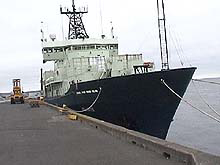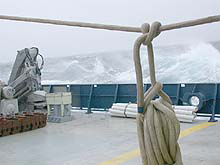Weather is not cooperating. . .
June 25, 2002
Catalina Martinez
NOAA Office of Ocean Exploration
We left the Port of Astoria, Oregon on board the R/V Atlantis on June 22, and although the skies were overcast, the seas were calm. The weather was predicted to get rough, as there were several low-pressure systems in our path. This caused a bit of apprehension as we discussed the allocation of Alvin dives between the three groups of scientists. Every dive day that is lost to weather can be a devastating blow to a science group, and by the look of the weather we had to assume that we would lose at least one dive on the first leg of the cruise.
The weather remained calm for the first day. By day two, however, the seas started to kick up. Since then, we have experienced swells ranging from 5 to 15 feet, with the largest swells occurring early in the morning and at night. Unfortunately, the weather is only predicted to get worse. For the first few days, the main topic of each conversation was who was seasick and who was not, and what seasickness medication was working for whom. Last night the weather became so rough that several people were thrown from their bunks, and some science gear was damaged from the waves.
The Role of Weather in a Scientific Cruise
Weather plays a very significant role in the success of a scientific cruise, as most scientific gear cannot be deployed in bad weather. Although the Alvin can be launched in marginal weather, it is the recovery operation that is most sensitive to weather conditions. If the weather is predicted to worsen as a day progresses, an Alvin dive may be cancelled, or the duration of the dive may be shortened. If the weather deteriorates during an Alvin dive, there are two options: the dive can be cut short so that the sub can return to the surface, or, in the event of a serious storm, the Alvin can actually remain on the bottom for up to three days. This has never happened, but a plan does exist for such an emergency.
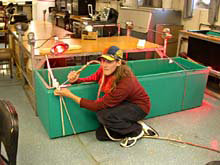
Zach Hoyt fixing cracks in the crab tank. The tank cracked from being hit by a large wave on the stern. Click image for larger view.
Weather is also a key factor in whether a scientific cruise is enjoyable or not. If you can imagine what it would be like to exist inside a washing machine while it is running, you can get the idea of what it is like to be on a ship out at sea in bad weather. Even the most basic tasks, such as walking, getting dressed, or eating are made difficult when the weather does not cooperate. Severe seasickness can cause a person to be incapacitated for days at a time and this is certainly no fun! Being at sea in stormy weather can be quite exciting at times, but existing on a ship in large swells gets old pretty quickly!
Approaching the First Seamount
We are scheduled to arrive at Murray Seamount by late evening June 25 or early morning June 26. As the time of arrival to the first seamount draws near, the science crew is growing anxious because the weather is not predicted to get any better. Nevertheless, it was decided that all should proceed with the original dive plan, even though the crew will not launch the Alvin if the weather does not improve.
The plan for the first Alvin dive at Murray Seamount is for the geology group to collect rock samples from depths ranging from 1,000 meters to 2,700 meters, using the Alvin claw and a rock collection basket.
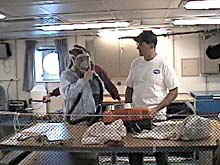
Taylor Heyl trying on the emergency breathing apparatus with Alvin pilot Bruce Strickrott instructing. Click image for larger view.
Safety at Sea and Sub Orientation
During the first few days at sea, the crew of the Atlantis always holds vessel safety drills that include instruction on how to know if there is an emergency on the ship, where to go in the case of an emergency, and what to bring with you in the event of an emergency. All newcomers to the Atlantis are also instructed on how to put on a survival suit and how to use an emergency breathing apparatus, both of which are located in the berths of all those on board the ship.
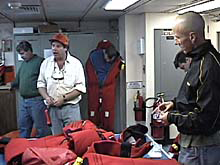
Third Mate Rick Bean instructs all newcomers on how to put on a survival suit. From left to right: Pat Hickey, Rick Bean, Mark Spear, Chris Morgan, and Kevin Threadgold. Click image for larger view.
All science crew and new pilots in training are given an intensive orientation in the Alvin sub prior to their first dive. Alvin pilots took advantage of the four-day steam to the first dive location to provide this orientation. All are instructed on safety issues such as not wearing any flammable clothing on board the sub, how to deal with a situation in which the pilot might become incapacitated, how to use the communication and video equipment, and yes, how to urinate while in the sub for up to eight hours! Alvin is constantly maintained by the technicians and pilots to be certain that it is in perfect condition prior to each dive. We have complete faith in this very talented team!
Sign up for the Ocean Explorer E-mail Update List.



























